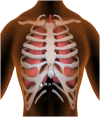Contemporary analysis of phrenic nerve injuries following cryoballoon-based pulmonary vein isolation: A single-centre experience with the systematic use of compound motor action potential monitoring
- PMID: 32584880
- PMCID: PMC7316283
- DOI: 10.1371/journal.pone.0235132
Contemporary analysis of phrenic nerve injuries following cryoballoon-based pulmonary vein isolation: A single-centre experience with the systematic use of compound motor action potential monitoring
Abstract
Background: Phrenic nerve injury (PNI) remains one of the most frequent complications during cryoballoon-based pulmonary vein isolation (CB-PVI). Since its introduction in 2013, the use of compound motor action potential (CMAP) for the prevention of PNI during CB-PVI is increasing; however, systematic outcome data are sparse.
Methods: The CMAP technique was applied in conjunction with abdominal palpation during pacing manoeuvres (10 mV, 2 ms) from the superior vena cava for 388 consecutive patients undergoing CB-PVI between January 2015 and May 2017 at our tertiary arrhythmia centre. Cryoablation was immediately terminated when CMAP amplitude was reduced by 30%.
Results: Reductions in CMAP amplitude were observed in 16 (4%) of 388 patients during isolation of the right veins. Of these, 11 (69%) patients did not manifest a reduction in diaphragmatic excursions. The drop in CMAP amplitude was observed in 10 (63%) patients during ablation of the right superior pulmonary veins (PVs) and in 7 (44%) patients during ablation of the right inferior PVs. Postprocedural persistent PNI was observed in three of four patients for a duration of 6 months, with one of these patients remaining symptomatic at the 24-month follow-up. One of the four patients was lost to long-term follow-up.
Conclusions: All PNIs occurred during right-sided CB-PVI and were preceded by a reduction in CMAP amplitude. Thus, the standardized use of CMAP surveillance during CB-PVI is easily applicable, reliable and compared with other studies, results in a lower number of PNIs.
Conflict of interest statement
The authors have declared that no competing interests exist.
Figures


Similar articles
-
Clinical experience with a novel electromyographic approach to preventing phrenic nerve injury during cryoballoon ablation in atrial fibrillation.Circ Arrhythm Electrophysiol. 2014 Aug;7(4):605-11. doi: 10.1161/CIRCEP.113.001238. Epub 2014 Jul 13. Circ Arrhythm Electrophysiol. 2014. PMID: 25017398
-
Factors Influencing Diaphragmatic Compound Motor Action Potentials During Cryoballoon Ablation for Atrial Fibrillation.J Cardiovasc Electrophysiol. 2016 Dec;27(12):1384-1389. doi: 10.1111/jce.13082. Epub 2016 Sep 19. J Cardiovasc Electrophysiol. 2016. PMID: 27558755
-
Clinical feasibility of pulmonary vein orifice pacing for the prediction of phrenic nerve injury during cryoballoon ablation of atrial fibrillation.J Cardiovasc Electrophysiol. 2019 Aug;30(8):1200-1206. doi: 10.1111/jce.13962. Epub 2019 May 15. J Cardiovasc Electrophysiol. 2019. PMID: 31045300
-
Characteristics of Phrenic Nerve Injury During Pulmonary Vein Isolation Using a 28-mm Second-Generation Cryoballoon and Short Freeze Strategy.J Am Heart Assoc. 2018 Mar 24;7(7):e008249. doi: 10.1161/JAHA.117.008249. J Am Heart Assoc. 2018. PMID: 29574457 Free PMC article.
-
Cryoballoon versus Radiofrequency Catheter Ablation in Atrial Fibrillation: A Meta-Analysis.J Cardiovasc Electrophysiol. 2016 Oct;27(10):1151-1159. doi: 10.1111/jce.13047. Epub 2016 Aug 16. J Cardiovasc Electrophysiol. 2016. PMID: 27422848 Review.
Cited by
-
Computer Simulation of Catheter Cryoablation for Pulmonary Vein Isolation.Healthcare (Basel). 2024 Jul 30;12(15):1508. doi: 10.3390/healthcare12151508. Healthcare (Basel). 2024. PMID: 39120212 Free PMC article.
-
A Simplified Approach to Pulmonary Vein Visualization during Cryoballoon Ablation of Atrial Fibrillation.Medicina (Kaunas). 2022 Nov 22;58(12):1700. doi: 10.3390/medicina58121700. Medicina (Kaunas). 2022. PMID: 36556902 Free PMC article.
-
Single-shot technique of cryoablation for atrial fibrillation has comparable effective and safety outcomes compared to standard technique: insights from multiple clinical studies.Front Cardiovasc Med. 2023 Sep 7;10:1195492. doi: 10.3389/fcvm.2023.1195492. eCollection 2023. Front Cardiovasc Med. 2023. PMID: 37745124 Free PMC article. Review.
References
-
- Casado-Arroyo Ruben, Chierchia Gian-Battista, Conte Giulio, Levinstein Moisés, Sieira Juan, et al. "Phrenic nerve paralysis during cryoballoon ablation for atrial fibrillation: a comparison between the first-and second-generation balloon." Heart Rhythm 10, no. 9 (2013): 1318–1324. - PubMed
-
- Meissner Axel, Maagh Petra, Christoph Arndt, Oernek Ahmet, and Plehn Gunnar. "ECG-guided surveillance technique in cryoballoon ablation for paroxysmal and persistent atrial fibrillation: a strategy to prevent from phrenic nerve palsy." International journal of medical sciences 13, no. 6 (2016): 403. - PMC - PubMed
-
- Lakhani Mayur, Saiful Faisul, Parikh Valay, Goyal Nikhil, Bekheit Soad, et al. "Recordings of diaphragmatic electromyograms during cryoballoon ablation for atrial fibrillation accurately predict phrenic nerve injury." Heart Rhythm 11, no. 3 (2014): 369–374. - PubMed
Publication types
MeSH terms
LinkOut - more resources
Full Text Sources
Other Literature Sources
Medical
Research Materials

